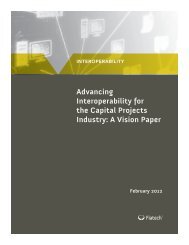An Introduction to ISO 15926 November 2011 - iRINGToday
An Introduction to ISO 15926 November 2011 - iRINGToday
An Introduction to ISO 15926 November 2011 - iRINGToday
Create successful ePaper yourself
Turn your PDF publications into a flip-book with our unique Google optimized e-Paper software.
doc<strong>to</strong>r’s office individually <strong>to</strong> find out if he or she is taking new patients and if there is a suitable<br />
open appointment. Using existing sources of information, you might get lucky and get an<br />
appointment with the first call, but it could easily take much longer.<br />
The Semantic Web is all about describing things in a manner that computers can understand,<br />
so that you can ask questions like the one in this example and let a digital assistant do the<br />
leg work. Using Semantic Web technology, data can be shared and reused across application,<br />
enterprise, and community boundaries.<br />
<strong>ISO</strong> <strong>15926</strong> has borrowed two technologies from the Semantic Web, OWL (Web On<strong>to</strong>logy<br />
Language) and RDF (Resource Description Framework). OWL is a language for creating on<strong>to</strong>logies,<br />
a concept we will discuss next. RDF is a way of s<strong>to</strong>ring information in declarations of<br />
truth using specific vocabularies, or on<strong>to</strong>logies, in a manner that makes the meaning machine<br />
readable.<br />
How We Know and Understand Things<br />
When we go beyond cus<strong>to</strong>m-built methods of exchanging information between two particular<br />
computer applications—when we try <strong>to</strong> design a way for any two computer applications <strong>to</strong><br />
exchange information without having <strong>to</strong> know anything at all about each other—we confront<br />
the question of how we represent knowledge. This is not just sophistry. When two people are<br />
having a conversation, they will naturally ask questions if they do not understand something<br />
or if they receive an unexpected response.<br />
But when software applications exchange information there is no opportunity <strong>to</strong> ask questions.<br />
The developers of these applications will make certain assumptions about the world,<br />
and therefore key terminology in the applications may differ. The solution is <strong>to</strong> embed the<br />
necessary context (that is, the understanding that humans bring) in<strong>to</strong> the data being exchanged.<br />
For this, we need <strong>to</strong> understand how we know things. The study of how we know<br />
things in philosophy and mathematics is called on<strong>to</strong>logy. We do not need an in-depth understanding<br />
of what on<strong>to</strong>logy is in order <strong>to</strong> understand <strong>ISO</strong> <strong>15926</strong>, but a brief, personal, example<br />
will be helpful.<br />
I, your humble author, ride a bicycle <strong>to</strong> work most days. (Among other things, it lets me indulge<br />
in the luxury of eating the fine Ukrainian food my wife cooks for me!) The distance <strong>to</strong><br />
work makes a nice workout but is beyond walking if the bicycle were <strong>to</strong> break down. Therefore,<br />
I have developed what you might call an On<strong>to</strong>logy of Things That Will Carry a Bicycle.<br />
Now, in Western Canada—which <strong>to</strong> most Europeans is but a few years out of the horse age—<br />
the pickup truck is king. In Western Canada, all “real men” have pickups. As you can see from<br />
Figure 2.2, there is ample room in a pickup truck <strong>to</strong> carry a bicycle. So, it is not difficult <strong>to</strong><br />
imagine that if my bicycle broke down on the way <strong>to</strong> work, I would try <strong>to</strong> think of everyone<br />
who owned a pickup truck that might have driven it <strong>to</strong> work that day.<br />
Fig. 2.2 Pickup truck.<br />
CHAPTER 2<br />
42



